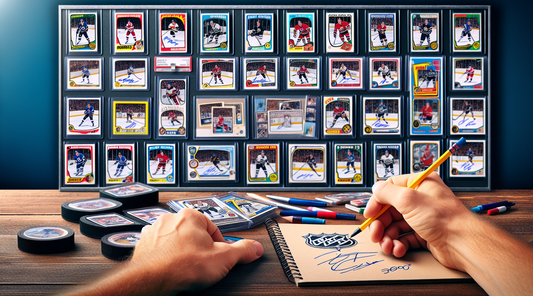Selling your hockey card collection can be a rewarding endeavor, but it requires careful planning. Start by staying informed about current market trends to understand the value of your cards. Organize your collection by player, team, and condition to maximize its appeal to buyers. Explore various selling platforms, both online and offline, to reach a wider audience. Optimize your listings with high-quality photos and detailed descriptions, and provide exceptional customer service to build trust with potential buyers. By following these expert tips, you can unlock the full potential of your collection and achieve maximum returns.
Understanding the Market: Researching Current Trends
As a hockey card collector looking to sell your collection, it's crucial to stay up to date with the latest trends in the market. Research recent sales and prices for specific cards to get a sense of their current value. Pay attention to player performance, popularity, and any news or events that might impact card values. Recognize the impact of supply and demand on card prices, as scarcity and high demand can drive up the value of certain cards.
Pro tip: Follow reputable hockey card websites, online marketplaces, and social media groups dedicated to hockey card collecting to stay informed about the latest trends and prices.
Preparing Your Collection: Organizing and Assessing Value
Before selling your hockey card collection, take the time to sort your cards by player, team, and condition. This organization will make it easier for potential buyers to browse your collection. Next, identify valuable and rare cards in your collection. Look for rookie cards, autographed cards, limited edition cards, and cards featuring popular players.
Grading your cards can greatly increase their potential value. Professional grading services such as PSA, Beckett, SGC and TAG will assess the condition and assign a grade to each card, which helps guarantee authenticity and gives a buyer confidence in what they're purchasing.
Pro tip: Keep track of your collection using a spreadsheet or inventory system, including key details such as player, team, condition, and market value. This will help you keep track of your cards and easily provide information to potential buyers.
Choosing the Right Selling Platform: Where to Sell Your Cards
When it comes to selling your hockey cards, there are various options available to you. Consider online marketplaces like eBay, COMC (Check Out My Cards), and Collectors Universe. These platforms have a wide reach and attract collectors from all over the world. Additionally, explore social media platforms and trading forums dedicated to hockey card collectors. Utilize hockey card-focused websites and forums where collectors often gather to buy and sell cards. Finally, consider local trading card shops and sports card shows in your area, as these venues can attract buyers who prefer to see the cards in person before making a purchase.
Pro tip: Take advantage of multiple selling platforms to increase your chances of finding the right buyer. Each platform has its own audience, so by listing your cards on different platforms, you cast a wider net and increase exposure to potential buyers.
Listing and Promoting Your Collection: Effective Selling Techniques
When listing your hockey card collection for sale, it's important to showcase your cards in the best possible light. Take high-quality photos of your cards, capturing details and any notable features. Write detailed and accurate descriptions for each card, including information about the player, team, year, and condition. Highlight any special attributes, such as autographs, memorabilia pieces, or limited edition prints. Consider offering discounts or bundle deals to incentivize buyers to purchase multiple cards.
Pro tip: Utilize SEO techniques when creating your listings. Use relevant keywords in your titles, descriptions, and tags to increase the visibility of your listings in search results.
Dealing with Potential Buyers: Negotiating and Closing the Sale
When communicating with potential buyers, it's essential to be responsive and professional. Respond to inquiries in a timely manner and provide accurate information. Clearly communicate your selling terms, including payment options and shipping methods. Be open to negotiation and engage in friendly and respectful discussions to find a mutually beneficial agreement. Use secure payment methods, such as PayPal, to protect both parties involved. When shipping the cards, carefully package them to ensure they arrive in the same condition they were sold.
Pro tip: Provide tracking information to buyers for their peace of mind. This helps build trust and ensures transparency throughout the transaction.
Additional Tips for Maximizing Returns: Going the Extra Mile
If you have higher-end cards in your collection, consider consignment services. Consignment allows you to sell your cards through a reputable dealer who can reach a broader audience and potentially secure higher prices for your cards. Explore auction houses that specialize in sports memorabilia and cards, especially if you have rare and valuable pieces. Attend sports card conventions and events where collectors and enthusiasts gather. These events provide an excellent opportunity to meet potential buyers and network with other collectors.
Pro tip: Build relationships with other collectors and traders. Networking within the hockey card community can lead to future opportunities for buying, selling, and trading cards.
The Importance of Proper Packaging and Shipping: Protecting Your Investment
When it's time to ship your hockey cards, it's crucial to protect them properly. Use top loaders, penny sleeves, and team bags to ensure the cards are secure during transit. Consider using bubble mailers or rigid cardboard for added protection. For high-value cards, consider insuring them or using registered mail to provide an extra layer of security. Finally, provide tracking information to the buyer so they can monitor the shipment and have peace of mind.
Pro tip: Include a thank you note or small token of appreciation with each shipment. This gesture goes a long way in building positive relationships with buyers and encouraging future purchases.













